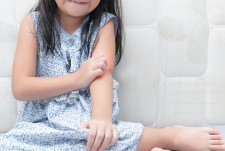Ringworm
What is ringworm?
Ringworm is the name for a group of skin infections caused fungus that live on the dead tissues of the skin, hair, and nails. The term “ringworm” doesn’t mean the infection is caused by worms.
What are the symptoms?
- The infection causes a rash that may have a ring shape with a raised edge.
- It can have scaly patches that are quite itchy and flaky. They can happen on the scalp, body, groin or feet.
- When the scalp is infected, there is often an area of baldness.
- Fungal infections on the feet are also known as “athlete’s foot”. They are usually very itchy and cause skin cracking between the toes.
How is it spread?
The fungus sticks to the fingers or gets under fingernails when someone with ringworm touches or scratches the rash. Fungi grow in moist, warm areas, such as locker rooms and swimming pools, then spreads when a person touches someone else or through contact with infected items like combs, unwashed clothing or shower and pool surfaces.
It’s also possible to become infected from contact with animals, like cats and dogs.
How can I protect my child or teen?
- Teach your child not to share their comb, hairbrush, face cloths or towels.
- Make sure your child or teen wears flip-flops on their feet in the locker room shower or at the pool.
- Wash sports clothing regularly. Because the fungi are on your skin, it’s important to shower after contact sports.
- Wash your hands often, especially after touching pets. It’s also a good idea to avoid touching pets with bald spots.
How is it treated?
Usually the skin can be treated with an antifungal ointment or cream that is applied to the infected area for at least 2-3 weeks. For more severe infections and scalp infections, prescription medication may need to be taken orally (by mouth).
When should I call the doctor?
- If you think your child has ringworm, see your doctor.
- If your child has ringworm, they should not return to child care or to school until after treatment has started.
Reviewed by the following CPS committees
- Public Education Advisory Committee
Last updated: July 2018

